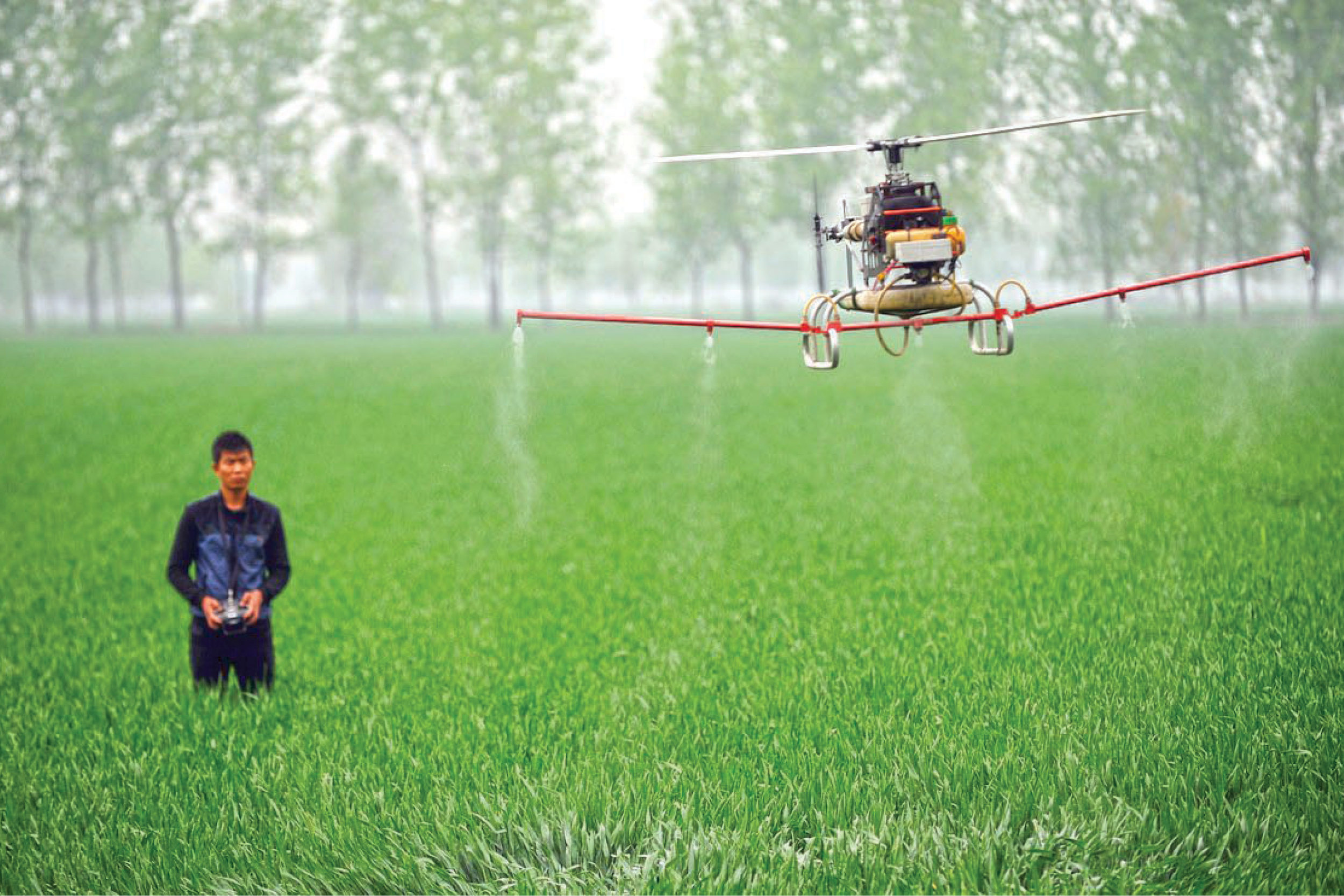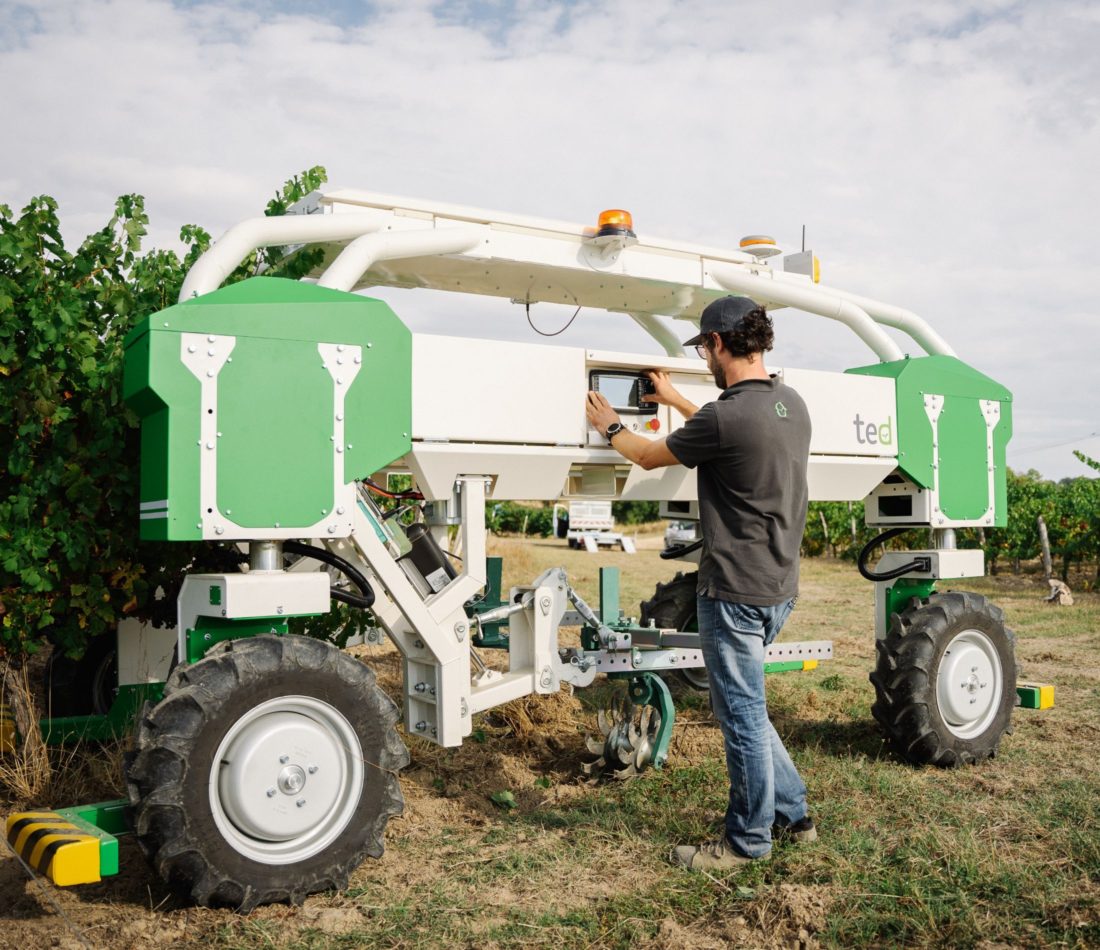In the New Agricultural sector, Robotic farming is set to revolutionize the Industry

In the agricultural sector, robotic farming is set to revolutionize the industry
Agriculture and technology have formed one of the most revolutionary collaborations in history. An essential industry in a country’s economic growth and stability is agriculture.
The agricultural industry has evolved from an essential occupation to a high-tech enterprise, and the standards continue to rise. In this article, we will examine robotic agriculture.
A robot can be designed, constructed, operated, constructed, manufactured, and applied in various ways. Robotics combines many different engineering and technological skills. Electronics, Engineering, mechatronics, and mechanics all have a role in robotics. The body is made of metal, and the wheels are mounted on the axles, connected to the motors, and the body needs to be balanced.
Powering the motors and connecting sensors to controllers requires electronics. The robot must then be controlled by the software, which understands the sensors and drives the robot. Research, design, and construction of new robots that serve various practical purposes continue to be a rapidly growing area of robotics today. Is there any chance of robots being introduced into farming now that they have taken off in various fields?
Farming Industry Needs Robotics

The human population is predicted to reach 9 billion in 2050 due to the world’s rapid growth. Agricultural production must grow dramatically to meet the demands of such a vast world. Perhaps this is the reason farmers are turning to robotics for assistance. It gives an idea about the impact of robotic farming.
Industries such as retail, manufacturing, mining, packaging, shipping, and transportation are already using robots to increase outputs and plan to double their participation in the future.
Growing populations, technological advancements, and new types of robots have led to the opening of the agriculture industry to innovation. By 2025, the agricultural robot market should reach $11,58 billion, being one of the most widely invested markets during the next decade.
Agricultural Robots: A History
In the 1920s, the first glimpse of robotics in agriculture can be traced back to the use of automatic vehicle guidance while doing research-related work—automated agricultural vehicles developed during the 1950s and 1960s as a result. Additionally, in both France and the United States, oranges have been harvested by robots in recent years.
For the outdoors, robots have been used in agriculture for decades, but they are more complicated and challenging to furnish than those used indoors in industrial settings. The process is a bit more difficult because of concerns over safety, the complexity of picking crops affected by different environmental factors, and the element of unpredictable circumstances.
Market Demand
The lack of labour and rising demands have loomed as a source of fear. Developing countries like Japan lack a sufficient workforce to meet labour market demands due to an ageing population. Similarly, in the US, this sector is heavily reliant on immigrants. Still, the country’s desire to stop immigration and the decline in seasonal farmworkers make it challenging to meet the minimums.
Robots can be used in agriculture for a variety of purposes

Farmer robots are typically used to perform tedious, repetitive, and time-consuming tasks. The farmers can use robotic farming to improve the overall yield by focusing more on this aspect.
Agricultural robots are commonly used to perform the following duties:
- Analyzing soils
- Phenotyping
- Control of weeds
- Sorting and packaging
- Picking and harvesting
- Environmental Monitoring
- Automated mowing, pruning, seeding, spraying
Many robotic farming companies are developing robots to help with crop care and harvesting. Xaver, a robot from Fendt that should be available this year, can plant and fertilize crops like corn, control weeds, and scout fields.
From San Diego comes vision robotics, which has developed robots to thin seedlings, which ensure their spacing is sufficient during planting, enhancing their growth.
Agriculture using robotics
Herbicide-resistant weeds have also resulted in $43 billion in losses due to robots. Farmers can also expect to save $43 billion by preventing herbicide-resistant weeds from growing. Several robotic farming companies, like Blue River Technology, have introduced See & Spray robots into the market and marketed them as effective weed-spraying machines in the market.
The task of monitoring huge agricultural fields is enormous. Farmers have never had access to such a detailed level of data about their crops as they do now, thanks to new sensors and geo-mapping technologies. These data can be collected autonomously by drones and ground robots.
TerraSentia robot from EarthSense is another example that autonomously moves through fields using sensors to monitor plant parameters, allowing it to analyze crops without any human assistance. In the future, it may be able to detect specific ailments in plants if further developed. Scientists will gradually determine which environmental factors are best for growing crops.
Robotic farming benefits
A critical step in nurturing healthy crops is to irrigate and fertilize them. Unfortunately, irrigating and fertilizing crops use excessive amounts of water. By targeting specific plants, robotic-assisted precision irrigation, for example, can help reduce water waste. Ground robots spray each plant directly with water, which autonomously manoeuvres through rows of crops.

Other machines won’t be able to get to areas that robots can. Advances in robotics will also help fill the human resource gap in agriculture. In the future, robots may be able to perform the work of 30 humans.
As a result, the farmers can focus their efforts on developing their business rather than performing manual labour. The resulting work and time savings will increase crop yields, proving that technological progress permeates every aspect of our lives. By empowering the farmers with this technology, they will spend less time on their business and more time on their business.
Growth of AgriTech Startups In India
India has relied on agriculture since the Indus Valley Civilization. According to the latest report, 70–18% of Indian households are still dependent on farming, contributing 17–18% to the GDP.
In India, agricultural technology startups hold great promise. Agritech startups are a huge opportunity for India’s farmers struggling with unpredictable weather patterns, water scarcity, price hikes, and many other issues.
What Are Agritech Startups?
In agritech, modern technologies are applied to the agricultural sector to increase production, generate income, and enhance economic productivity.
Application, practice, product, and service enhancements may be applied either as inputs or outputs in agricultural processes.
Agritech Startups in India: What Makes Them Unique?
Farmers face numerous challenges to sustaining their livelihood through farming today. India’s farmers are becoming increasingly concerned about unfair practices in unorganized agriculture markets and the lack of appropriate marketing systems.
The company also faces poor transportation and storage services, among other issues. The lack of access to superior technology makes them vulnerable and leave them without agricultural solutions.
These startups can significantly impact the future of Indian agriculture by addressing these challenges right from the start. This is the chance for Indian farmers to be knighted in shining armour.
Agritech Startup Initiatives by the Indian Government

The Government of India has been actively working to improve farmers’ lives in India. A government official recently announced that by the end of 2022, the government would double farmers’ income.
Nirmala Sitharaman, Minister of Finance, said that the government would foster value-added farmers’ produce to boost farm incomes.
To provide real-time advice to farmers, the NITI Aayog partners with IBM to provide technology-driven solutions. Consequently, crop-yield protection models are being developed using artificial intelligence.
Startups in agriculture in India
Indian agriculture benefits significantly from the Agritech sector, raising farmers’ incomes. Agritech startups currently number 450 in India, and NASSCOM reports their growth is 25% a year.
The last few years have seen several Agritech startups emerge in India. From 43 startups in 2013 to more than 1,000 startups in 2020, the Agritech sector has grown due to increased rural internet penetration, supply chain losses, growing investor interest, etc.
Using agricultural technology can now solve problems like using outdated equipment, maintaining supply chains, ensuring proper infrastructure, and enabling farmers to access a broader range of markets efficiently.
Recent reports show that a total of $3.23 billion was invested in the agriculture sector worldwide. Agritech startups from India raised $313 million of this total. The Indian startup industry is experiencing a dramatic shift, and these figures will inspire young entrepreneurs to explore agriculture technology.
India’s Agritech Startups: Which States are on top?
Several states have established startup ecosystem hubs to facilitate the success of Agritech startups and the growth of agriculture. Agritech startups in the last five years have mainly been located in Karnataka and Maharashtra.
Despite Gujarat’s low share of Agritech startups, the state is the leading state in the Indian Agritech startup ecosystem hub, according to The Department of Industrial Policy & Promotion’s State Startup Ranking Report 2018.
The problems of traditional farming
- Lack of Knowledge of using fertilizer:
Farmers will benefit from fertilizer when used appropriately, but surplus quantities damage the crops and yields. Farmers are facing problems due to a lack of knowledge of the use of these chemicals, and they are mistakenly drinking the water containing fertilizer for their plants and die as a result.
- Lack of Man Power:
Labourers on farms are paid less than those on construction sites. Many workers choose to work in construction or other fields to earn a living rather than in farming.
- Farmers Suicides:
More than 17,000 farmers have committed suicide and ended their lives in Maharashtra, Andhra Pradesh, and Karnataka from 2006-to 2007. The above problems can be resolved, and the Indian agriculture sector can be improved greatly by using robotics with innovative intelligence and making intelligent robots that help improve farming and livestock grazing. Research is ongoing, and it will take some time to establish the technology in farming.
Advantages of Robotic Farming

Considering those robotics will make a perfect entry into agriculture due to the above crises, here are some of the advantages of robot farming.
- Labour is eliminated – The farmer is relieved of milking and the associated rigid schedule. Instead, his time is devoted to feeding, watching over, and supervising the animals.
- Unemployed people who think farming is a nightmare are allowed to become self-employed by this program.
- The cost of farming will drastically decrease due to this one-time investment.
- By reducing fertilizer, pesticide, insecticide, herbicide and water usage, we can significantly reduce our environmental footprint.
- Agriculture, grazing, and farming are revolutionized.
- A significant increase in productivity will be realized.
- A farmer will no longer be a challenging occupation; farming will become a choice for engineers, and many young people will be engaged in agriculture.
- Testing the soil provides us with information about the soil. When that information is taken as intelligence and signalled to artificial intelligence and robotics, it yields perfect results that can improve the quality.
India’s farm robot market:
Several companies and researchers have developed small and heavy farm equipment for traditional farming, but precision farming requires some robotics or pneumatics. The introduction of robots in the fields mentioned above leads us to wonder why robotics has not yet penetrated the agricultural sector.
In the same way that robots can be used for transplanting seedlings to avoid intensive labour, robots for weed control could help reduce herbicide usage. A few years ago, we read newspaper articles about innovative rural technologies, such as cell phones to control electric motors; this is very helpful to farmers during summer because the power supply is irregular.
Using sensors and hand-held PDAs in agriculture will greatly improve computation and accuracy if we think about advanced intelligent machines in farming. The agriculture sector faces several obstacles in all countries, particularly in India. According to the newspaper, farmers are disappearing in India. It was mentioned by the famous writer Shineveramya that farmers are our country’s eyes.
It is excellent that farmers provide us with food, but their numbers are diminishing these days. People are leaving the farming profession by repeating some common phrases about it being profitable and how nobody wants to lose money. It is becoming riskier with each passing year. Several drawbacks. Especially the youth. Therefore, the young men are interested in working in the construction industry and not in agriculture.
Several companies and researchers have developed small and heavy farm equipment for traditional farming, but precision farming requires some robotics or pneumatics. The introduction of robots in the fields mentioned above leads us to wonder why robotics has not yet penetrated the agricultural sector. In the same way that robots can be used for transplanting seedlings to avoid intensive labour, robots for weed control could help reduce herbicide usage.
A few years ago, we read newspaper articles about innovative rural technologies, such as cell phones to control electric motors; this is very helpful to farmers during summer because the power supply is irregular. Using sensors and hand-held PDAs in agriculture will greatly improve computation and accuracy if we think about advanced intelligent machines in farming.
The agriculture sector faces several obstacles in all countries, particularly in India. According to the newspaper, farmers are disappearing in India. It was mentioned by the famous writer Shineveramya that farmers are our country’s eyes. It is excellent that farmers provide us with food, but their numbers are diminishing these days. People are leaving the farming profession by repeating some common phrases about it being profitable and how nobody wants to lose money.
It is becoming riskier with each passing year. Several drawbacks. Especially the youth. Therefore, the young men are interested in working in the construction industry and not in agriculture.
Conclusion
Even though these machines possess incredible potential, they unavoidably spark the old, archaic fear that robots will replace human labour. Using these automata as supervisors and operators can be viewed positively.
Food demand is outpacing available land for growing crops, so farmers are the only ones who can meet it. The use of robotics in agriculture will boost the agricultural process and increase outputs.
Startups in the agritech sector are in high demand right now. As more entrepreneurs establish businesses here, the industry will significantly transform. Several government policies are also helping these startups find investors more easily. Farmer can finally expect better price realization now due to a new initiative.
The age of robotics agriculture is still in its early stages, with most inventions being in the trial and development phase. Agricultural robots can cause a massive altercation and prove that humans will also steer AI in the future.
Frequently Asked Questions
- How will robotics in agriculture change in the future?
With Agricultural Robots, jobs for skilled workers will be created, and farmers will have to be more advanced in their skills to work alongside robots. Future fleet managers will control robotic farming systems and autonomous vehicles, replacing today’s farmworkers.
- In agriculture, how can robots be used?
Robots are used to harvest and pick produce, control weeds, mow autonomously, prune, spray, seed, and thin crops.
- What is the future of the agricultural robots market?
According to many researchers, the agricultural robot market is expected to grow by over 20% each year until 2022. Most farms today use robotics for milking cows or indoor machinery. Most farms today use robotics for milking cows or indoor machinery. Eventually, robotics will also be used outdoors.
- What are some popular agricultural robots?
Ecorobotix, Nano Technologies, Energid Citrus Picking System, Blue River LettuceBot2, Agribotix, Vision Robotics, and RoBoPlant are some popular robots in agriculture.
- How can AI help agriculture?
Artificial intelligence-powered agriculture bots assist farmers in weeding their crops more efficiently. Artificial intelligence bots can harvest crops faster than human labourers in the agriculture field. Using computer vision, weeds can be monitored and sprayed.
- What are agricultural robots?
With agricultural robots, slow, repetitive, and tedious tasks can be automated, allowing farmers to improve overall productivity. In agriculture, robotic equipment is used for: Harvesting and picking plants, controlling weeds, autonomous mowing, trimming, seeding, spraying, and thinning crops.




